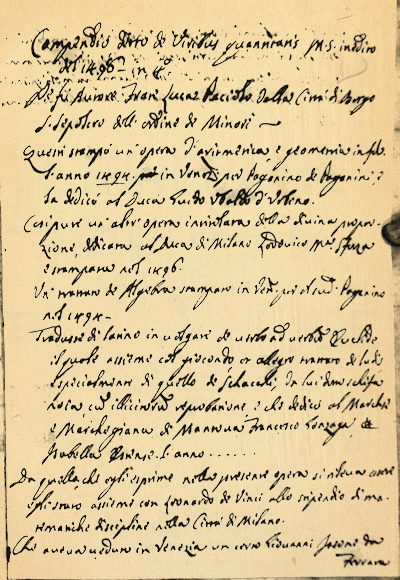
Waiting for the Olympic Games in Paris, discover the illusionistic side of the Ville Lumière with a collection of posts curated by magic historian Mariano Tomatis.
Flipping through old magic books allows us to immerse ourselves in the atmosphere of the shows of yesteryear, but the potential of those pages goes far beyond the simple evocation of a lost time: by cross-referencing descriptions and illustrations, many magic tricks can be brought back to life, creating faithful replicas and reactivating their enchantment.
In preparation for episode 146 of the webseries Mesmer in pillole, in September 2019 I created a figure pendue de basteleur (“figure of the dangling acrobat”), discovered among the papers of a seventeenth-century manuscript.

MS Typ 530: La magie du Pont Neuf : où sont contenus les jeux et subtilités des basteleurs, Paris 1643, p. 279.
The trick was regularly presented (and perhaps sold) on the Pont Neuf, an open-air theatre where wandering magicians performed, and for five soldi, the magician Pinetti sold Persian powder: rubbed on teeth, it cured caries, tartar and removed stains. This is the place where everything is deceptive, starting with the name.

Even though it is called “the new bridge”, it is the oldest in the city: it dates back to 1607. It is the heart of illusory Paris, at least since 1643, the year in which La magie du Pont Neuf (“The Magic of the Pont Neuf”) was written – an illustrated anthology of conjuring tricks, described so well that it is possible to recreate them identically four centuries later.
Leafing through the manuscript in the edition transcribed and annotated by Philippe Saint-Laurent, one illustration had fired my imagination: that of an acrobat performing on the bridge. The anonymous author did not describe a man in the flesh, but a cardboard figurine, a kind of puppet capable of twirling, clinging with his hands or feet to a support.

Visiting the bridge today, I brought the ingenious origami home and took a photograph of it.

You too can make your own dangling figure, following the instructions provided!
Print, cut out this image and glue it to a thick card:

Cut along the edges of the two shapes and fold the first one as described in steps A and B.

To get to step C, fold back the strip making sure it crosses the other. Then glue the two ends 1 and 2 onto the corresponding numbers of the rectangle reproduced in the lower right, making sure that the side with the writing goes to the back. For the acrobat to move with fluency, the folds will have to be very pronounced, an effect you will achieve by repeatedly folding and unfolding the figurine on either side.
The figure pendue de basteleur du Pont Neuf is an application of the principle behind the “solazo puerile detto bugie” described at the end of the 15th century by Luca Pacioli in De Viribus Quantitatis, ch. CXXXII.

Luca Pacioli
De Viribus Quantitatis
Biblioteca Universitaria, Bologna 1496.
An image of the trick appears on Bernardino Luini’s painting “Puttino che gioca,” coeval with Pacioli’s book.

In the sixteenth century, Jean Prévost describes the “Tablettes fort gentiles” in La Première partie des subtiles et plaisantes inventions, Antoine Bastide, Lyon 1584, ff. 67v-69v: the book also has a clear illustration (f. 69r) that was useful for me to reconstruct the game and show it in the episode 108 of Mesmer in pillole (18.2.2019).

Jean Prévost
La Première partie des subtiles et plaisantes inventions comprenant plusieurs jeux de récréation et traicts de soupplesse, par le discours desquels les impostures des bateleurs sont descouvertes
Antoine Bastide, Lyon 1584.
In the 18th century, a spicy version of the game is published under the title “Le Maitre & les Valets” by Edmé-Gilles Guyot in Nouvelles récréations physiques et mathématiques, Vol. 4, No. VII, Gueffier, Paris 1775, pp. 55-8.

Edme-Gilles Guyot
Nouvelles récréations physiques et mathématiques
Vol. 4, N. VII, Gueffier, Paris 1775 (I ed. 1769).
I also reconstructed this for the episode 106 (16.2.2019). To the same principle I dedicated the episode 111 (21.2.2019). The mechanism is now the basis of the very popular “Himber wallet,” put on the market by Richard Himber in the 1950s. Volker Huber reconstructed the history of the trick in “The Yawning Mouth” in Gibecière, No. 1, Winter 2005, pp. 13-46. Concatenating more than two tablets results in the toy now called “Jacob’s Ladder.” With the right manipulation it is possible to create the illusion that one piece of wood is magnetic and can dangle by adhering to one side or the other of a second tablet. I show the effect in episode 109 (19.2.2019). The Pont Neuf acrobat exploits the same mechanism.
The anonymous manuscript La magie du Pont Neuf : où sont contenus les jeux et subtilités des basteleurs, Paris 1643 (MS Typ 530) is held at the Houghton Library, University of Cambridge (Massachusetts); the acrobat is described on pp. 279-82. Dániel Margócsy digitized and transcribed the entire manuscript, making the material available on his website.

La magie du Pont Neuf : où sont contenus les jeux et subtilités des basteleurs
Paris 1643.
A printed version with commentary by Philippe Saint Laurent was published in 2015 for Editions Georges Proust, Paris 2015.
Of Pinetti’s “Persian powder” Edouard Fournier wrote in a two-volume work all about the bridge: Histoire du Pont Neuf, Vol. 2 (of 2), Dentu, Paris 1862, pp. 574 ff.

Édouard Fournier
Histoire du Pont-Neuf
Vol. 2, E. Dentu, Paris 1862.
The Pont Neuf crosses the Seine at the western tip of the Île de la Cité: on the rive droite it starts from the point where Quai du Louvre becomes Quai de la Mégisserie, on the rive gauche from the point where Quai de Conti becomes Quai de Grands Augustins.
BY-NC-SA 4.0 • Attribution-NonCommercial-ShareAlike 4.0 International